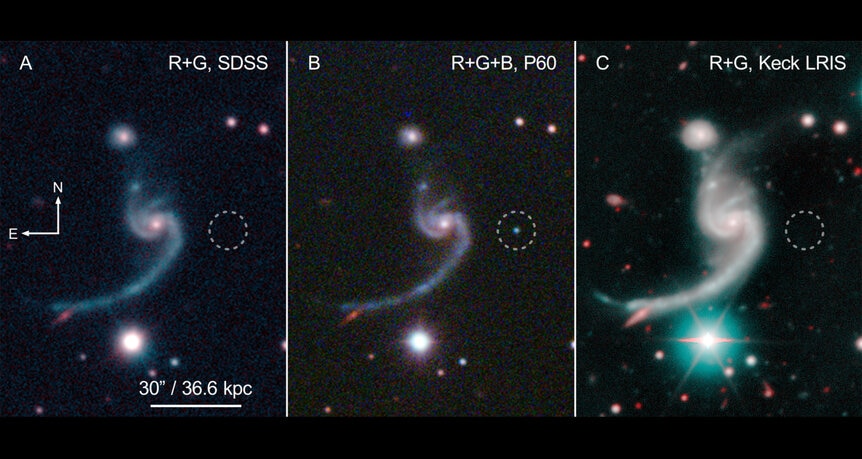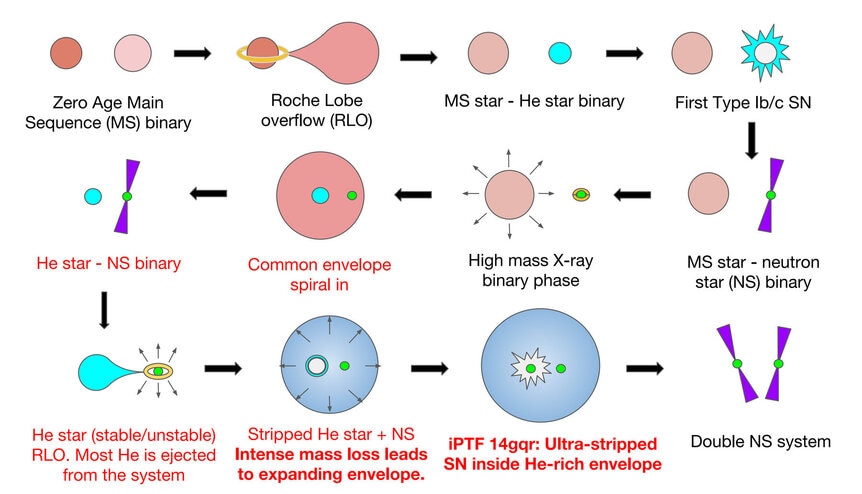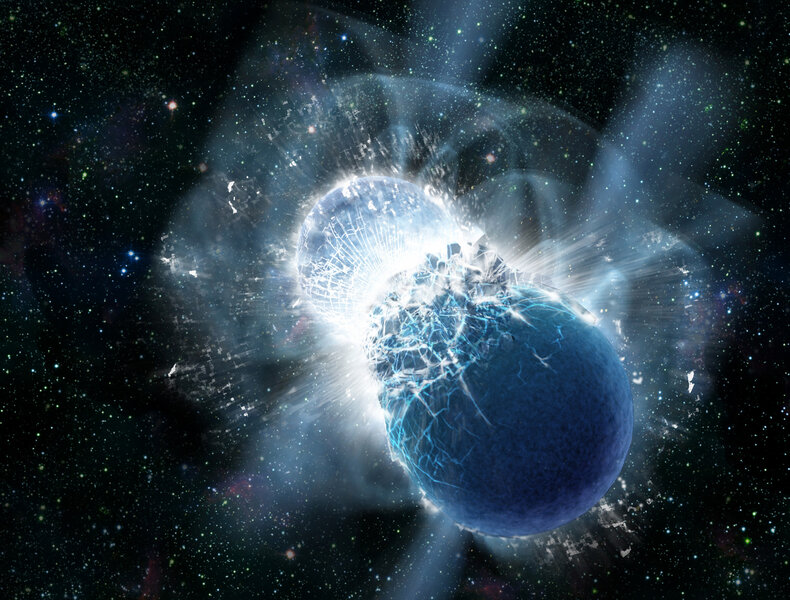Create a free profile to get unlimited access to exclusive videos, sweepstakes, and more!
For the first time, astronomers see the birth of a neutron star binary system
A brief and rapidly fading blip of light from a distant galaxy has given astronomers a glimpse into a never-before-seen event: The birth of a binary neutron star system.
Oh yeah, stuff like this makes my brain tingle. There’s a lot of fun things here.
The galaxy is called IV Zw 155 (the 155th galaxy in astronomer Fritz Zwicky’s fourth edition of his galaxy catalog). It’s pretty far away, about 850 – 900 million light years or so, but even at that distance you can see it’s a weird spiral, with wide-flung arms just screaming out that the galaxy recently suffered a collision with another galaxy. That’s neither here nor there to our story, but hey, it’s still cool.
On October 14, 2014, the intermediate Palomar Transient Factory — a wide-angle camera fitted to a relatively small telescope that scans the skies looking for things that change brightness rapidly, what astronomers call transients — happened to be looking at the chunk of sky containing IV Zw 155, and saw a bright spot next to it that wasn’t there literally the day before.
Astronomers pounced on this, suspecting a supernova, an exploding star, and called it SN 2014ft (a supernova in 2014, with the letters indicating its place in the order of supernovae seen that year). They rapidly followed up with observations in various wavelengths of light including ultraviolet, infrared, and eventually X-rays and radio waves, too. What they found was… weird.
For one thing, it never showed up in X-rays or radio waves, which is a little odd for a supernova. But what really baked their noodle* was that the object faded very rapidly, like within a day. Then, as if to show off how strange it was, it got a little brighter for a few days before fading rapidly again.
Yeah, supernovae don’t usually do this… or, to be more accurate, they can exhibit behavior similar to this but not this extreme. They usually take many days to brighten, and fade over weeks and months. So what’s going on?
It turns out this is an example of what’s called an “ultra-stripped envelope supernova”. You can think of a massive star as having two layers: a core of dense gas undergoing fusion in the center, surrounded by a huge layer of hot mostly hydrogen gas called the envelope. In a normal supernova, the core runs out of nuclear fuel and collapses. This sets off a complicated chain of events (which, if you wish, you can find out all about in my episode of Crash Course Astronomy) that results in the core collapsing, which releases a vast amount of energy, and I do mean vast. This explosion tears through the outer envelope, giving it enough energy to send it screaming away at a good fraction of the speed of light. The core, for its part, compresses down either into a dense neutron star or a black hole.
A supernova gets bright in part because the envelope gets very hot in the event and expands rapidly, becoming huge, giving it a lot of surface area in which to emit light. But there are variations to this event that can change things up.
A very rare variation is what astronomers think is at the heart of what they saw with SN 2014ft. Here’s what happened according to what the data show…
Long ago, two massive stars were born very close together. One of them reached the end of its life first and exploded, becoming a neutron star. After time, the other star also began to die, running out of nuclear fuel. It grew into a red supergiant, engulfing the neutron star companion: The neutron star actually orbited inside the envelope of the red supergiant!
As it did it stirred things up, and the first star’s envelope got ejected in the process — a little bit like when you turn a mixer on too fast and drop it into a bowl of batter, splattering batter droplets everywhere. In this case, the second star’s hydrogen envelope is blown away in a roughly spherical wind, creating a vast expanding bubble of gas around the system.
At that point the second star is basically just a big core with a neutron star orbiting it. At some point, it runs out of fuel and collapses. KABOOM! Supernova. Some of the upper layers of the star are blasted away, but the explosion is dim, because there’s almost no material left to light up. So it gets bright, but then fades rapidly.
A few days later this exploded stuff catches up to and slams in to the envelope that was ejected previously, and so we see a brightening, but it’s short-lived as well. The whole thing dims to invisibility far faster than your usual supernova.
But the best part is what’s left over. The second star has become a neutron star as well! That means we now have two neutron stars in a tight orbit around one another. That’s pretty rare, although we’ve seen a few of these systems here and there. But we’ve never seen the event that spawned a neutron star binary system before, making this a first!
That’s very cool, and will lead to all kind of important science to help us understand how and why stars explode.
But there’s one more thing…
You may recall back in October 2017 when astronomers euphorically announced detecting gravitational waves from a pair of merging neutron stars. If not, you can read all about it. This was the first time an event was seen optically (via telescopes) as well as through the powerful gravitational waves blasted out, and it marked a huge advance in our understanding of such things. It also, not so incidentally, confirmed that merging neutron stars create huge amounts of rare elements including gold, something that had been theorized for some time but had lacked good observational evidence. It was a transformative event in astronomy.
And now we have seen the other end of that phenomenon, when a binary neutron star system is born! Someday, probably not for billions of years, but someday, the neutron stars that announced their existence to us with SN 2014ft will do the same thing. They’ll approach either other gradually, spiraling in, then eventually merge. There will be a huge flash of energy, the fabric of spacetime will shake in response, and astronomers across the Universe savvy enough in science to build the right detectors will be able to experience it.
And, like us, hopefully their understanding of the cosmos will take a big leap, too.
* Sorry, I just happened to rewatch "The Matrix", and I like the Oracle.

















